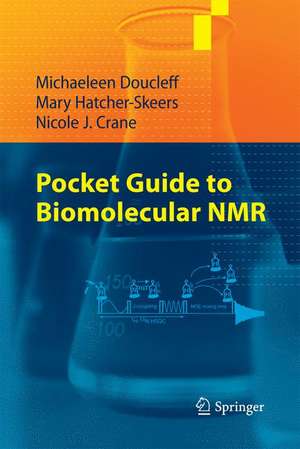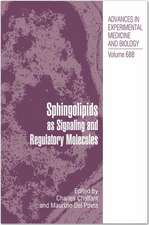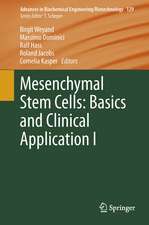Pocket Guide to Biomolecular NMR
Autor Michaeleen Doucleff, Mary Hatcher-Skeers, Nicole J. Craneen Limba Engleză Paperback – 20 ian 2011
Preț: 463.35 lei
Preț vechi: 545.12 lei
-15% Nou
Puncte Express: 695
Preț estimativ în valută:
88.67€ • 96.29$ • 74.48£
88.67€ • 96.29$ • 74.48£
Carte disponibilă
Livrare economică 01-15 aprilie
Preluare comenzi: 021 569.72.76
Specificații
ISBN-13: 9783642162503
ISBN-10: 3642162509
Pagini: 150
Ilustrații: XI, 159 p. 82 illus.
Greutate: 0.2 kg
Ediția:2011
Editura: Springer Berlin, Heidelberg
Colecția Springer
Locul publicării:Berlin, Heidelberg, Germany
ISBN-10: 3642162509
Pagini: 150
Ilustrații: XI, 159 p. 82 illus.
Greutate: 0.2 kg
Ediția:2011
Editura: Springer Berlin, Heidelberg
Colecția Springer
Locul publicării:Berlin, Heidelberg, Germany
Public țintă
Upper undergraduateCuprins
Atomic Bells and Frequency Finders
Bonded Bells and Two-Dimensional Spectra
Neighboring Bells and Structure Bundles
Relaxation Theory Part One: Silencing of the Bells
Relaxation Theory Part Two: Moving Atoms and Changing Notes
Protein Dynamics.
Bonded Bells and Two-Dimensional Spectra
Neighboring Bells and Structure Bundles
Relaxation Theory Part One: Silencing of the Bells
Relaxation Theory Part Two: Moving Atoms and Changing Notes
Protein Dynamics.
Notă biografică
Currently an Assistant Editor for the journal Cell, Michaeleen Doucleff obtained her PhD in Chemistry from the University of California, Berkeley while working in the lab of David E. Wemmer. Doucleff then became a Nancy Nossal postdoctoral fellow at the National Institute's of Health in the lab of G. Marius Clore. Throughout her career, she has used NMR spectroscopy and X-ray crystallography to characterize the structure and dynamics of transcription factors and their interaction with DNA.
Mary Hatcher-Skeers is a Professor of Chemistry in the Joint Science Dept. of Claremont McKenna, Pitzer and Scripps Colleges in Claremont CA. She teaches General Chemistry, Biochemistry, Physical Chemistry and NMR Spectroscopy. Hatcher-Skeers received her PhD in Chemistry from the University of Washington while working in the lab of Gary Drobny. She was then a NIH Post-Doctoral Fellow in the labs of Judith Herzfeld at Brandeis University and Robert Griffin at MIT. Professor Hatcher-Skeers’ research uses solid-state and solution NMR spectroscopy to investigate the role of DNA structure and dynamics in protein and drug binding. She has trained over 70 undergraduates in her research lab, a number who have gone on to graduate programs in chemistry and biochemistry.
Nicole Crane, Ph.D. is currently a Scientist at the Naval Medical Research Center in Silver Spring, MD where she is establishing the Regenerative Medicine Department’s Advanced Imaging Program. Her research focuses on development and utilization of spectroscopic techniques to improve understanding of the wound healing process, particularly in traumatic acute wounds, as well as identifying and quantifying transplant-associated ischemia and reperfusion injury. Her experience as an applied spectroscopist includes applications in forensics, pharmaceuticals, and biomedicine. Dr. Crane has published overfifteen peer-reviewed publications and presented at numerous regional and national scientific meetings. She is also an inventor on two US patents.
Mary Hatcher-Skeers is a Professor of Chemistry in the Joint Science Dept. of Claremont McKenna, Pitzer and Scripps Colleges in Claremont CA. She teaches General Chemistry, Biochemistry, Physical Chemistry and NMR Spectroscopy. Hatcher-Skeers received her PhD in Chemistry from the University of Washington while working in the lab of Gary Drobny. She was then a NIH Post-Doctoral Fellow in the labs of Judith Herzfeld at Brandeis University and Robert Griffin at MIT. Professor Hatcher-Skeers’ research uses solid-state and solution NMR spectroscopy to investigate the role of DNA structure and dynamics in protein and drug binding. She has trained over 70 undergraduates in her research lab, a number who have gone on to graduate programs in chemistry and biochemistry.
Nicole Crane, Ph.D. is currently a Scientist at the Naval Medical Research Center in Silver Spring, MD where she is establishing the Regenerative Medicine Department’s Advanced Imaging Program. Her research focuses on development and utilization of spectroscopic techniques to improve understanding of the wound healing process, particularly in traumatic acute wounds, as well as identifying and quantifying transplant-associated ischemia and reperfusion injury. Her experience as an applied spectroscopist includes applications in forensics, pharmaceuticals, and biomedicine. Dr. Crane has published overfifteen peer-reviewed publications and presented at numerous regional and national scientific meetings. She is also an inventor on two US patents.
Textul de pe ultima copertă
Steering clear of quantum mechanics and product operators, "Pocket Guide to Biomolecular NMR" uses intuitive, concrete analogies to explain the theory required to understand NMR studies on the structure and dynamics of biological macromolecules. For example, instead of explaining nuclear spin with angular momentum equations or Hamiltonians, the books describes nuclei as "bells" in a choir, ringing at specific frequencies depending on the atom type and their surrounding electromagnetic environment.This simple bell analogy, which is employed throughout the book, has never been used to explain NMR and makes it surprisingly easy to learn complex, bewildering NMR concepts, such as dipole-dipole coupling and CPMG pulse sequences. Other topics covered include the basics of multi-dimensional NMR, relaxation theory, and Model Free analysis. The small size and fast pace of “Pocket Guide to Biomolecular NMR” makes the book a perfect companion to traditional biophysics and biochemistry textbooks, but the book's unique perspective will provide even seasoned spectroscopists with new insights and handy “thought” short-cuts.
Caracteristici
Easy-to-understand guide into the subject Specifically written for life scientists Avoids complex mathematics Includes supplementary material: sn.pub/extras












